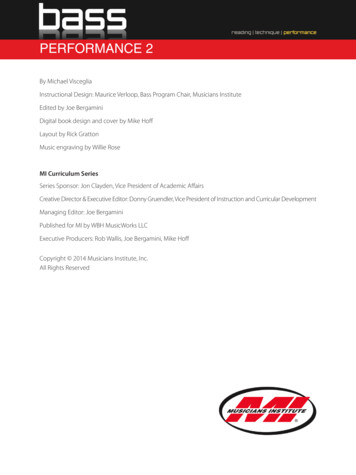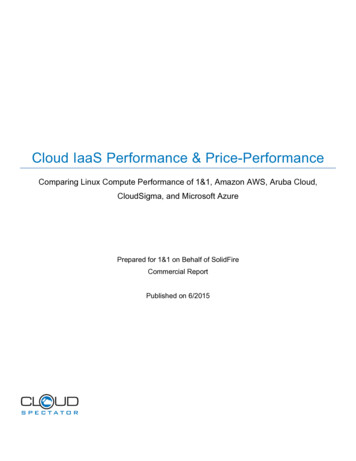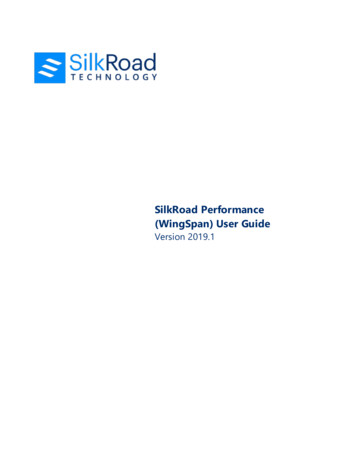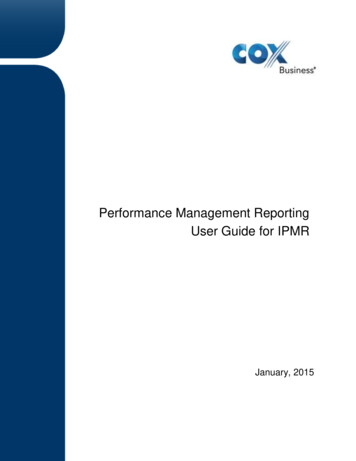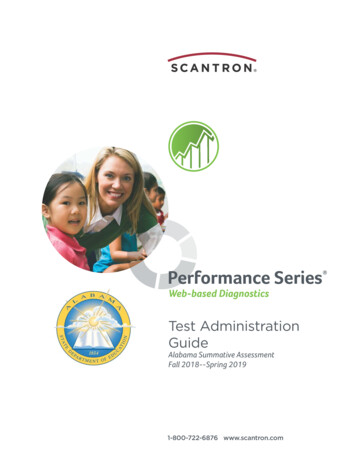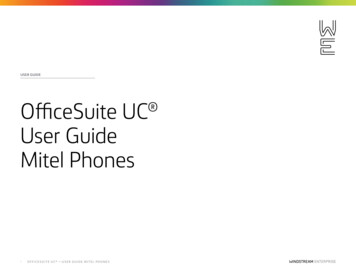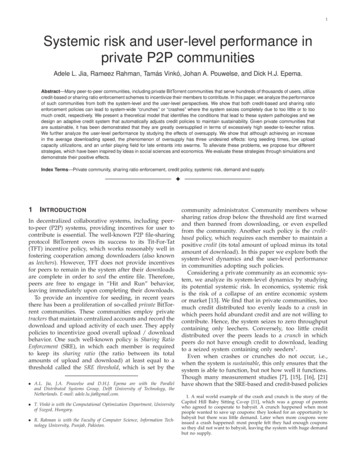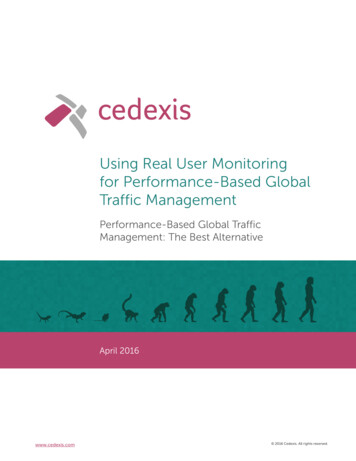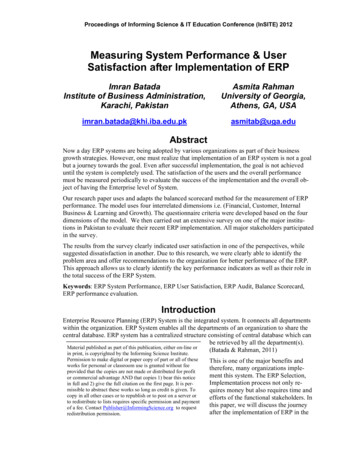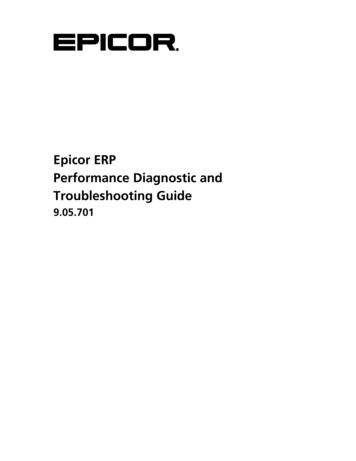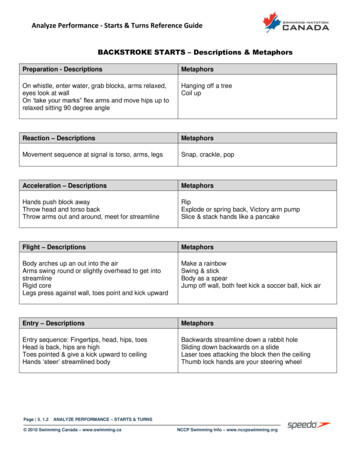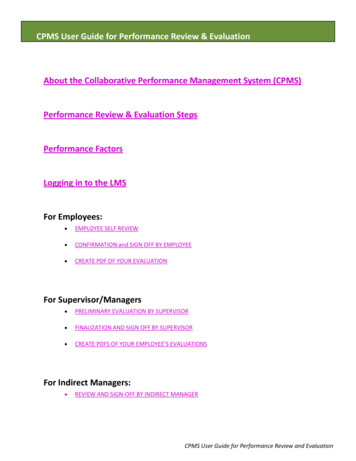
Transcription
CPMS User Guide for Performance Review & EvaluationAbout the Collaborative Performance Management System (CPMS)Performance Review & Evaluation StepsPerformance FactorsLogging in to the LMSFor Employees:EMPLOYEE SELF REVIEWCONFIRMATION and SIGN OFF BY EMPLOYEECREATE PDF OF YOUR EVALUATIONFor Supervisor/ManagersPRELIMINARY EVALUATION BY SUPERVISORFINALIZATION AND SIGN OFF BY SUPERVISORCREATE PDFS OF YOUR EMPLOYEE’S EVALUATIONSFor Indirect Managers:REVIEW AND SIGN-OFF BY INDIRECT MANAGERCPMS User Guide for Performance Review and Evaluation
About CPMSWhat is Collaborative Performance Management System (CPMS)?Performance management is a form of good people management. The Collaborative Performance Management Systemis a systematic and ongoing process of communication and collaboration between a supervisor and an employee duringa year-long performance management cycle. It aligns individual performance to the County’s strategic priorities and supports individual learning and development. The performance management cycle has three parts:Performance Planning and Goal Setting: to clarify expectations, set goals and define what successful performancelooks like, as documented in the employee’s individual performance plan.Performance Feedback and Coaching: to let employees know how they are doing and encourage learning and effective future performance.Performance Review and Evaluation: to discuss and document performance during the year based on feedbackgiven throughout the cycle, and set the stage for next year’s performance planning and goal setting.What is the purpose of this User Guide?This User Guide outlines the workflow of the Performance Review and Evaluation phase of CPMS, as facilitated by LMS.The Learning Management System (LMS) has many tools to support people’s use of CPMS.Who is the User Guide for?This guide is for employees, supervisors/managers, and indirect managers.As an employee you can create your Employee Self Review, confirm and sign-off on the Final Evaluation, and create a PDF of the Evaluation.As a supervisor to the employee (referred to as an supervisor or manager throughout this guide) you can, draft thePreliminary Evaluation, finalize and sign-off on the final evaluation, and create a PDF of the Evaluation.As an indirect manager you can review and sign off on the Evaluation.What is a Performance Review and Evaluation?Performance Review is the process resulting in the creation of a formal evaluation which summarizes prior feedback anddiscussions of performance over the course of the review period. The formal evaluation reflects the extent to which expectations set at the beginning of the cycle were met. Supervisors are expected to have regular informal communicationduring the year through scheduled “one-on-one” meetings and with “on-the-spot” discussions regarding the status of aparticular project or assignment.When are Performance Evaluations completed?Performance Reviews and Evaluations are to be completed annually. All employees are to be evaluated at the sametime, in synch with the fiscal year. Probationary employees are to be evaluated at least once during their probationaryperiod. This typically occurs 30 days prior to the end of their probationary period, or based on the departmental or position requirements.CPMS User Guide for Performance Review and Evaluation
Performance Review and Evaluation StepsThere are seven steps in the CPMS Performance Review and Evaluation, five (5) of which are facilitated by and completed with the Learning Management System (LMS). The five steps done in the LMS shown in the graphic above andare italicized below. Performance Review and Evaluation Steps1.Preparation of Supervisor and Employee (outside of the LMS)2.Employee Self Review3.Preliminary Evaluation and Update by the Supervisor4.Performance Review and Evaluation meeting (outside of the LMS)5.Review and sign-off by Indirect Manager6.Finalization and Sign-off by Supervisor7.Confirmation and Sign-off by EmployeeOnce the above steps are complete, the Employee and the Supervisor can begin planning for the future performancecycle.CPMS User Guide for Performance Review and Evaluation
Performance Factors INDIVIDUAL CONTRIBUTIONQuantityArrives at work on timeIs punctual with lunch hour and break periodsPerforms appropriate amount of work or services on Attention to SafetyFollows safety processes and procedures and dema timely basisonstrates safe behavior in all actions and activitiesQualityExtent to which the work is complete, thorough, effective and accurateInnovationTakes calculated risks for the benefit of customersand/or the organizationUses information technology to improve effectiveness and achieve results PROFESSIONALISMAdherence to County Standards and PoliciesIntegrityAssumes responsibility and accountability for decisions and actionsDemonstrates high standards of honesty, trust, andopennessIs open-minded when presented with a new perspective or new ideasRespectLooks for other solutions when traditional methodsdon’t workCooperationLevel of EffortIs self-motivated and maintains effort despite obstacles and setbacksAccomplishes assigned individual goals and objectives effectively, efficiently, and according to standards and expectationsTreats all persons with courtesy and respectWilling to help othersValues others’ input and expertise and is willing tolearn from othersConsistently develops and sustains cooperativeworking relationshipsIs receptive to feedbackAsks for and accepts help or assistance when neededSees opportunities or identifies potential problemsand takes the initiative to follow through rather thanResponsivenesswait for problems to ariseAnticipates and responds to external changeCommitment to ServiceCommitted to quality public service through statements and actionsTakes personal responsibility for meeting commitments to internal and external customers and correcting problemsReadily adjusts priorities to respond to currentneeds and changing customer demandsAttendanceComplies with attendance requirementsIs flexible when faced with external constraints, andadapts methodology and ideas quickly to immediateor anticipated changes in the external environmentReliabilityCan be depended upon to accept assignments andcomplete work and projects on timeDoes what needs to be done to deliver and achieveresultsMaintains a professional demeanor in stressful anddifficult situationsCPMS User Guide for Performance Review and Evaluation
Performance FactorsAdaptabilityAdapts behavior and work methods in response tonew information, changing conditions, or unexpected obstacles to get the best out of a situationUnderstands other people’s points of viewEthical conduct INTERPERSONAL SKILLSOrally expresses ideas and facts in a clear, organized,and convincing manner in a style, tone, and level appropriate to the audience and the occasion PROBLEM SOLVING and JUDGEMENTExpresses facts and ideas in writing in a clear, convincing, and organized manner that is appropriate tothe audience and the occasionQuality of job-related decisionsRespects cultures and values different from one'sBehaves in a fair and ethical manner toward othersIdentifies the cause of problems and finds the neces- ownsary resources andinformation to solve the problemsInterpersonal CommunicationRe-sets priorities based on changing needs or newrequestsListens empathicallyMaintains the best interests of the County as well ascustomersWorks jointly with others and is open to differentand opposing perspectives in order to achieve betteroutcomesMakes sound job-related decisions, develops alternative solutions and recommendations and selectsproper course of action; understands impact of decision and actionsTakes responsibility for understanding the reasoningbehind key policies, practices and proceduresOrganizational skillsPrioritizes workload and manage information flowefficientlyLeadershipIs proactive in approach to the jobShows initiative and flexibility in meeting challengesand solving problemsCreativityDevelops new methods and approaches for the purpose of improvementResolves interpersonal conflict effectivelyKeeps management informed of decisionsUses multiple channels to ensure effective communication (email, phone, meetings) JOB SPECIFIC CONTRIBUTIONJob specific knowledgeUnderstands job procedures, methods, components,facts and information related to assignmentsRemains up to date with job-related laws, regulations, policies, procedures, trends, and developmentsJob specific skillsApplies appropriate technical and procedural skillsrelated to assignmentsCPMS User Guide for Performance Review and Evaluation
Performance Factors MANAGING EMPLOYEE PERFORMANCE (for Managers and Supervisors)Recommending or Selecting TalentMakes selection decisions that are objective, fair,consistent, job related, and documentedResponds to employees’ needs, ensuring they havethe necessary resources to do their workActs to correct behaviors and performance that areinconsistent with goals, standards, and expressedvalues and interestsValues cultural diversity and individual differences inthe workforceInitiates and supports progressive disciplinary actionwhen coaching and corrective actions fail to correctperformance or conduct problemsUses the probationary period properly and effectivelySupports programs and activities that promote employee well being and balance.Coaching and Developing TalentEvaluating PerformanceProvides or ensures that staff receives on going andtimely feedback, coaching, and mentoring to increase skills/knowledge and improve performanceCommunicates goals, standards and expectations atthe beginning of the annual performance management cycleIdentifies, plans and/or provides training, support,and growth experiencesProvides timely feedback and coaching throughoutthe year so that annual performance evaluationscontain no surprisesthat support and enhance goal achievement andperformanceDelegates effectively to develop staff and build productive capacityConducts performance evaluations annually andwrites clear and constructive narratives to supportratingsRecognizes and rewards achievements and contribu- Operating within Legal, Labor, and Policy FrameworkTreats all employees in a fair and equitable mannertionsMaintains a work environment free of illegal bias orLeadershipdiscrimination, harassment, and retaliationPolitical Astuteness - Considers probable support oropposition to ideas or actions based on political interest and constraintsSets priorities to align work with, and in support of,agency or division goalsUses strategies to promote team morale and productivityManaging the WorkEnsures that processes are in place to achieve program/unit goalsEnsures that service quality meets the appropriatestandards andexpectationsAsks questions to encourage team input and focusesteam on the topic at hand.Plans, organizes and prioritizes the work of the uniteffectivelyActs to promote a cooperative environment conducive to personal and professional development andemployees’ sense of belonging.d. Manages financial resources wisely to contain orreduce costsMakes difficult or controversial decisions when necessaryMaintaining High Standards of PerformanceEstablishes and clearly communicates performancegoals and expectations DISCRETIONARY FACTOR - OTHER(To be added by Supervisor)Instructions: Add criteria applicable to the Department or Unit, not already covered by the Countywide categories.CPMS User Guide for Performance Review and Evaluation
Logging into LMS1) Go to www.co.sanmateo.ca.us/LMS.2) From the drop down, select the My Career Development Site.3) Login using your nine-digit employee ID number (found on your e-advice) and enter your LMS password. You havethree tries to enter your password before the system will lock you out for one hour.If you forgot your password, click on the Forgot Your Password link to reset it.If you have login difficulties, contact your Department LMS Administrator.CPMS User Guide for Performance Review and Evaluation
EMPLOYEE SELF REVIEWThe Employee Self Review is one of the first steps in creating the Review and Evaluation in the Learning ManagementSystem. This step is illustrated in the CPMS workflow below. You may notice that in this step both Employee Self Review and the Preliminary Evaluation by Supervisor are highlighted by colored boxes in the same column. This is becauseboth reviews are intended to be completed at or around the same time, and prior to moving forward to the next step,the Preliminary Evaluation Meeting. However, if an employee does not complete the Self Review, the supervisor canstill move forward with the Performance Evaluation and may “submit” the evaluation to his/her Manager after havingmet with the employee to discuss the Preliminary Evaluation, updating the evaluation (if applicable).CPMS User Guide for Performance Review and Evaluation
EMPLOYEE SELF REVIEWFrom the Home Page, under the Your Task Section 1) click on the Self Review Task to navigate to the first page in theLearning Management System (LMS) Performance Review and Evaluation.1Self Review of Emmy Employee What, Where or Why is That?The Self Review tasks appear on the Users Home Page, under Your Tasks.Each task has a due date assigned to it. The due date listed on the right hand side of the task name.Up to 3 tasks will be shown on the Home page, in the Your Tasks Section. To view additional and/or completed tasks:Click on “View All” (which appears at the bottom right when three or more tasks are shown) to navigate to the“Scheduled Tasks” Page or click on “Scheduled Tasks” from the colored navigation bar under the “Home” Tab.Tasks past their due date will have a yellow exclamation point toSelf Review of Emmy Employeethe right of the task name.Emmy Employee Performance EvaluationCPMS User Guide for Performance Review and Evaluation
EMPLOYEE SELF REVIEWBefore beginning, get familiar with the Navigation Bar. The Navigation Bar is on theleft-hand side of every page in the Performance Module. The Navigation Bar willguide the User through the available pages of the Performance Evaluation.While completing the Employee Self Review, there are four action buttons availableat the bottom of Navigation bar: Save, Cancel, Print and Submit. There is also an attachments button which allows for attachments to be uploaded to Learning Management System (LMS), including them with the Evaluation (maximum 3 attachmentsper Evaluation).Clicking “Save” will save the work completed. It will save the information entered during this log in aswell as other information entered prior. ** If you have not begun any work in the LMS the “Save” button will not appear.**Clicking “Cancel” will cancel the work completed/entered during this log in. It will not cancel priorsaved work, if any.Clicking “Print” will create a PDF of the Performance Review and Evaluation in its current status.If you click on “Submit” a pop-up window will appear. The window will warn that clicking submit and“OK” means you will not be able to modify your responses once you have submitted the self-review. Inaddition, clicking “OK” will send a notification to your supervisor/manager letting him/her know thatyou completed the Employee Self Review. ** If you have not begun any work in the LMS the “Submit”button will not appear.**CPMS User Guide for Performance Review and Evaluation
EMPLOYEE SELF REVIEW1) Click “continue” below the Collaborative Performance Management System workflow or click on Employee SelfReview in the Navigation Bar to move to the Employee Self Review Page.1 What, Where or Why is That?The Employee Self Review Overview page (above) shows the CPMS workflow in the middle of the screen and has aNavigation Bar on the right hand side. The only area accessible to the employee (as shown by the green dot ) at thistime is “Employee Self Review”.The Employee Self Review Page has instructions for the employee at the top of the page. To read the full instructions,use the scroll bar on the right hand side of the instruction box.CPMS User Guide for Performance Review and Evaluation
EMPLOYEE SELF REVIEW1) Type your response to the corresponding question in the free form text boxes provided. Responses can be cut andpasted from a Word document but, they may need to be reformatted. The text can also be bolded, italicized, underlined, bulleted and/or numbered by clicking on the associated format icon.1 What, Where or Why is That?The Employee Self-Review gives you an opportunity to respond to nine questions where you provide your input to yoursupervisor regarding your performance during the Performance Review and Evaluation period and identify areas forfuture support and growth. It also it informs the conversation between an employee and the supervisor during the Performance Review and Evaluation meeting. The nine questions are:1. List your job Performance Goals and comment on your success in achieving each one during this Performance Review Period.2. List your professional Development Goals and comment on your success in achieving each one during this Performance Review Period3. Comment on your success in meeting the relevant Performance Factors for your position. Provide specific examples when possible.4. What do you feel were your greatest contributions to the organization during this Performance Review Period?5. Where did you experience difficulties, challenges or obstacles?6. What suggestions do you have for improving the efficiency, effectiveness, or service orientation of your division ordepartment?7. What do you see as your Performance Goals for the year ahead?8. What do you see as your Development Goals for the year ahead?9. How can your supervisor and/or manager help you in achieving these goals?CPMS User Guide for Performance Review and Evaluation
EMPLOYEE SELF REVIEWWhile completing the Employee Self Review, there are four action buttons available at the bottom of the Employee SelfReview screen: Previous, Save and Exit, Save and Continue, and Submit. 1) Submit only when you have a final productIf you click on “Previous” the system will take you back to the Performance Reviewand Evaluation Overview page. The information entered during this log in will besaved.If you are not finished and want to save your work, click on “Save and Exit.” The system will return you to the Performance Evaluation Overview page and work completed/entered during this log in will be saved.If you click “Save and Continue” the system will take you back to the PerformanceReview and Evaluation Overview page and work completed/entered during this log inwill be saved.If you are finished, click “Submit”. A pop-up window will appear.Clicking “OK” will send a notification to your supervisor letting him/her know that youcompleted the Employee Self Review. And, as the pop-up window indicates, clicking“submit” and “OK” means you will not be able to modify your responses. The nextstep is the Performance Evaluation Meeting with your supervisor.CPMS User Guide for Performance Review and Evaluation
PRELIMINARY EVALUATION BY SUPERVISORYou may notice that both the Employee Self Review and the Preliminary Evaluation by Supervisor are highlighted by colored boxes in the same column. This is because both reviews are intended to be completed ator around the same time and prior to moving forward to the next step, the Preliminary Evaluation Meeting.However, if an employee does not complete the Self Review, the supervisor can still move forward with thePerformance Evaluation, the Preliminary Evaluation Meeting, and may update and “submit” the Evaluationto his/her Manager for review. What, Where or Why is That?The Collaborative Performance Management System (CPMS) workflow is shown on the CPMS Overview page. Theworkflow has the Employee Self Review and the Preliminary Evaluation by the Supervisor shown in the same step(same column). If the two boxes are highlighted by a color (as shown in the first graphic below) the Emplo
Oct 11, 2005 · Performance Reviews and Evaluations are to be completed annually. All employees are to be evaluated at the same time, in synch with the fiscal year. Probationary employees are to be evaluated at least once during their probationary period. This typically occurs 30 days prior to the end of th
